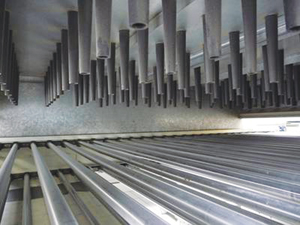With summer coming to a close, we can now consider putting away retarders and flow enhancers, which were needed so badly on those really hot days, and change the chemistry of our wood coatings and lacquers in response to the weather.
Free Webcast: Finishing Technology AdvancesOriginal Broadcast Date: |
|
 |
|
Sponsored by: |
|
|
EXEL North America, Inc. |
This is the time of year when I occasionally hear about blushing. On those warm fall days when the temperature is still up but it rains or is damp, the heat of the air makes the solvents in your lacquer flash off faster. But the moisture in the air is attracted to that cool lacquered surface, and all of a sudden you have a cloudy finish — that’s blushing. The only solution, in most cases, is sanding off the lacquer and starting over, because the moisture goes right down into the coating.
For you solvent-based spray users, keep that retarder handy and remember to add some on days like I mentioned above.
Water-borne Another Story
For those who use water-borne coatings, the use of additives isn’t always the most productive. With the arrival of cooler weather, let’s take a look at what my friend from Tillamook, on the cool Oregon coast taught me. It’s a great winter tip.
Evidently, I had strongly encouraged this fellow to keep his water-borne lacquer warm several years ago and he came up with an innovative way to take my words to heart. He went to Bed, Bath and Beyond and purchased an electric candle warmer. That’s a low temperature “hot plate” that will melt a candle and allow the fragrance to escape and fill a room.
Stick one of these under your gallon of water-borne lacquer and it will keep it warm, reducing the viscosity. Lower viscosity helps those normally thick fluids to spray out and atomize better. Viscosity will become more and more of an issue as the days and nights cool.
 Speaking of viscosity, let’s talk about wood coating viscosity relative to the use of a viscosity cup.
Speaking of viscosity, let’s talk about wood coating viscosity relative to the use of a viscosity cup.
Do you own one? If not, get yourself one. It really doesn’t matter which one you get because there are at least 21 cups in common use. Just remember that the one you have may not be the same one your buddy has; they may not give the same results for the same liquid. SATA Spray Equipment has a neat conversion chart for the 21 most popular models. It’s in their catalog or drop me a note and I’ll send it to you.
Viscosity cups, essential when measuring vicosity, are simply a ladle with a hole in the cup. The handle keeps you from getting messy doing your measuring test. You dip the ladle in the coating until the entire cup is submerged. Then, as you pull it out, just as the rim breaks the surface, you click a stopwatch. The hole, or orifice, in the bottom of the cup allows the fluid to flow back out of the cup at a given rate. The stop watch continues to tick as long as the stream is coming out of the hole. As soon as the stream skips, when the cup finally empties, you click the watch. That number represents your viscosity. Practice a few times looking for this skip. Watch the stream…not the fluid in the cup.
Learn by measuring different things: water, lacquer thinner, clear coat. Try it with something really thick. Put some clear coat in the refrigerator for an hour and then re-measure it. Put the can in the sun for an hour and then test again. Put the can on the concrete floor overnight and then test again.
Write down all the results. But do the test the same way every time.
Put a good thermometer in the shop or in the booth. Get one of those indoor/outdoor versions and put one sensor over your paint bench and the other in the booth. Record those temps along with the viscosity so that you know seconds at that temperature. Play with this valuable tool until you find the combination of viscosity and temperature that works the best with your equipment and application methods, then stick to that viscosity.







Have something to say? Share your thoughts with us in the comments below.